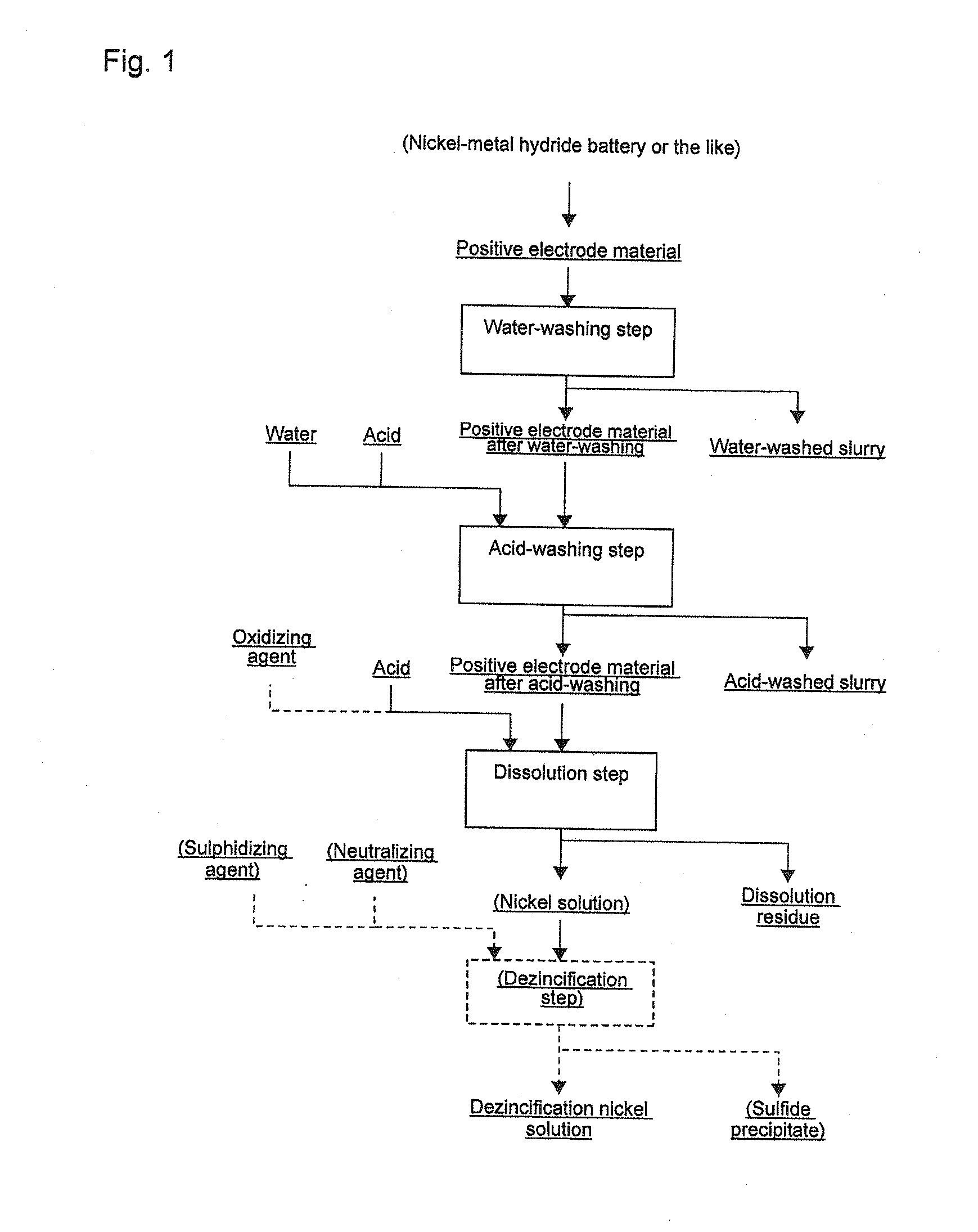Method for producing nickel-containing acid solution
- Summary
- Abstract
- Description
- Claims
- Application Information
AI Technical Summary
Benefits of technology
Problems solved by technology
Method used
Image
Examples
example 1
[0065]A residual electric charge was deactivated by reduction roasting in advance, and at the same time, a spent nickel-metal hydride battery in which nickel and cobalt were reduced to a metal state was disassembled and separated, and a positive electrode material as taken out. Next, the positive electrode material was cut into cut pieces by using a cutting machine so that the side length was within a range of 1 to 5 cm, and 1 kg of the positive electrode material already roasted was prepared and used in the following steps. Note that the deactivation treatment of a battery residual charge by reduction roasting was carried out in such manner that a spent nickel-metal hydride battery was charged into an electric furnace, and, while nitrogen gas was flown to create an inert atmosphere, a temperature of 550 degrees C. was maintained, and reduction roasting was performed for one hour.
[0066](1) Water-Washing Step
[0067]To 1 kg of the positive electrode material already roasted, 10 liters ...
example 2
[0073]The nickel solution A obtained in Example 1 had a Zn concentration in the solution of 1.1 [g / L], and therefore a dezincification step shown below was carried out.
[0074](4) Dezincification Step
[0075]Into a dezincification bath having a capacity of 2 liters, 1 liter of the obtained nickel solution A was poured. Hydrogen sulfide gas was blown into the dezincification bath at a flow rate of 0.3 g / min, and at that moment, nickel carbonate was added so that a pH of a generated slurry was maintained within a range of 2.0 to 2.5.
[0076]Stirring further continued for 10 minutes in this state to promote a reaction. After completion of the reaction, contents in the dezincification bath were filtered to separate into a solution and a sulfide precipitate, whereby a dezincification nickel solution A was obtained. Table 1 shows component analysis results. As shown in Table 1, compared with the nickel solution A, contained zinc is reduced from Ni / Zn=82 to 890, that is, to approximately one-ten...
example 3
[0077]Under the same conditions and operation as in (1) the water-washing step of Example 1, 1.1 kg of already-roasted positive electrode material equivalent to one in Example 1 were water-washed, separated, and dried to obtain a positive electrode material after water-washing having a weight after drying of 0.97 kg. Then, under the same conditions and operation as in (2) the acid-washing step of Example 1, the positive electrode material after water-washing was acid-washed, separated, and dried to obtain a positive electrode material after acid-washing having a weight after drying of 0.94 kg.
[0078]Furthermore, the positive electrode material after acid-washing was charged into a leaching bath having a capacity of 15 liters, and 8.0 liters of water were added thereto, and then, while a solution temperature was maintained at 70 degrees C., chlorine gas was blown from a cylinder at a flow rate of 1 liter per minute as an oxidizing agent. After stirring for 8 hours in this state, the b...
PUM
| Property | Measurement | Unit |
|---|---|---|
| Concentration | aaaaa | aaaaa |
| Concentration | aaaaa | aaaaa |
| Concentration | aaaaa | aaaaa |
Abstract
Description
Claims
Application Information
 Login to View More
Login to View More - R&D
- Intellectual Property
- Life Sciences
- Materials
- Tech Scout
- Unparalleled Data Quality
- Higher Quality Content
- 60% Fewer Hallucinations
Browse by: Latest US Patents, China's latest patents, Technical Efficacy Thesaurus, Application Domain, Technology Topic, Popular Technical Reports.
© 2025 PatSnap. All rights reserved.Legal|Privacy policy|Modern Slavery Act Transparency Statement|Sitemap|About US| Contact US: help@patsnap.com

